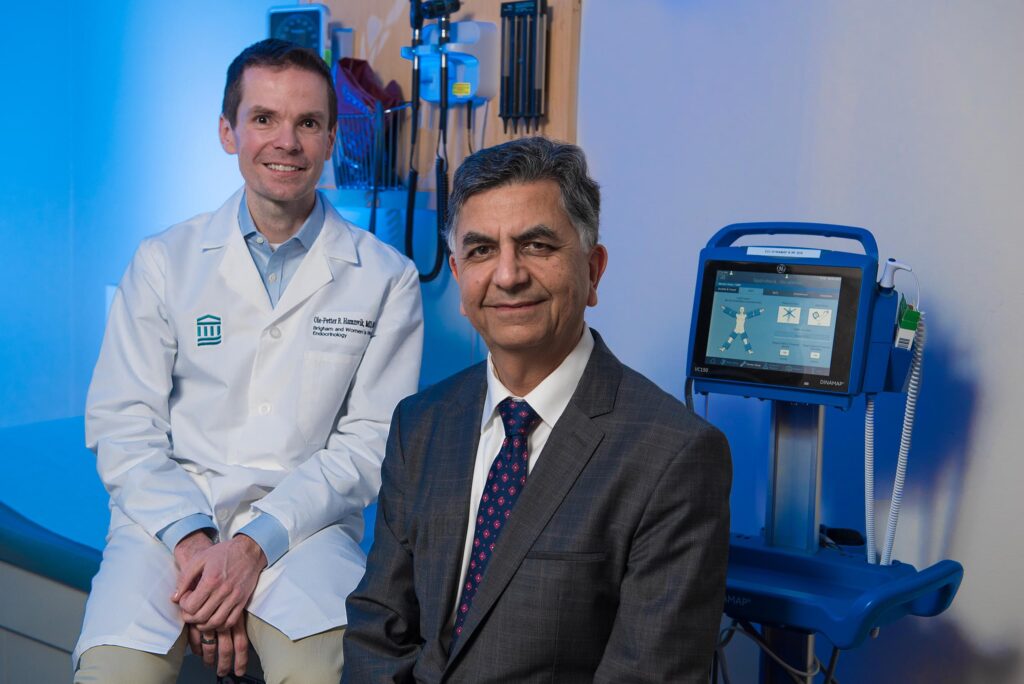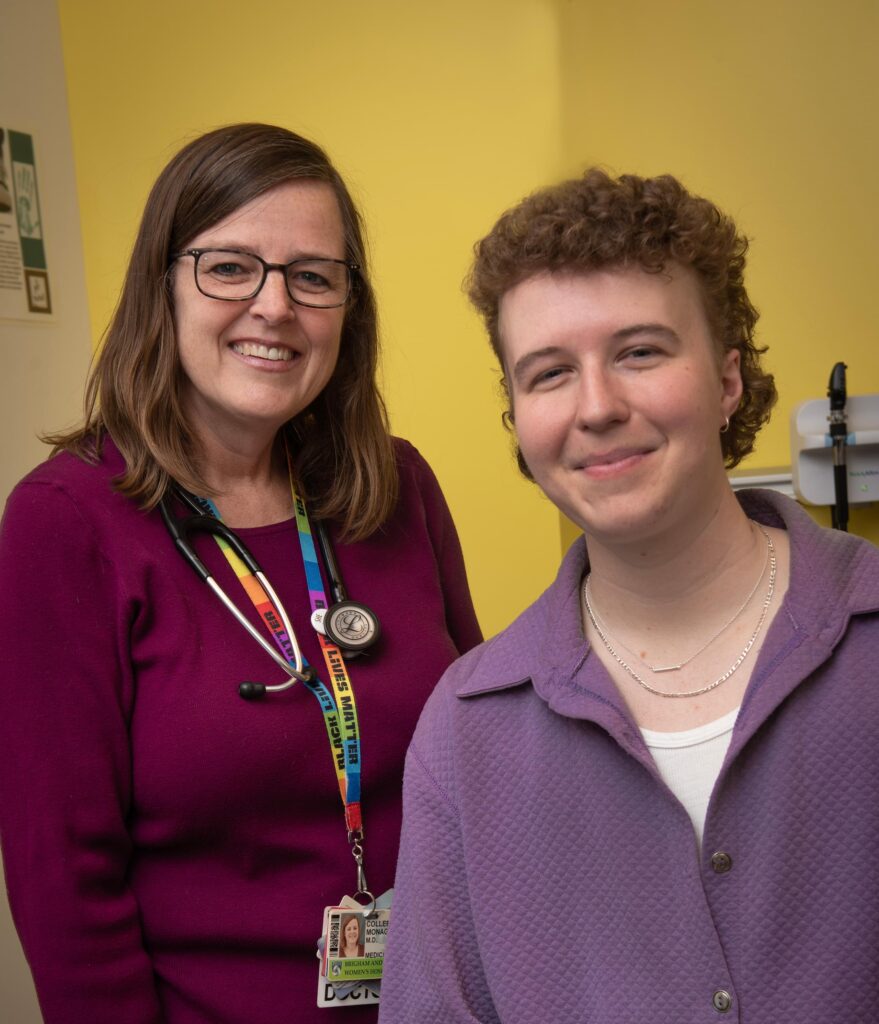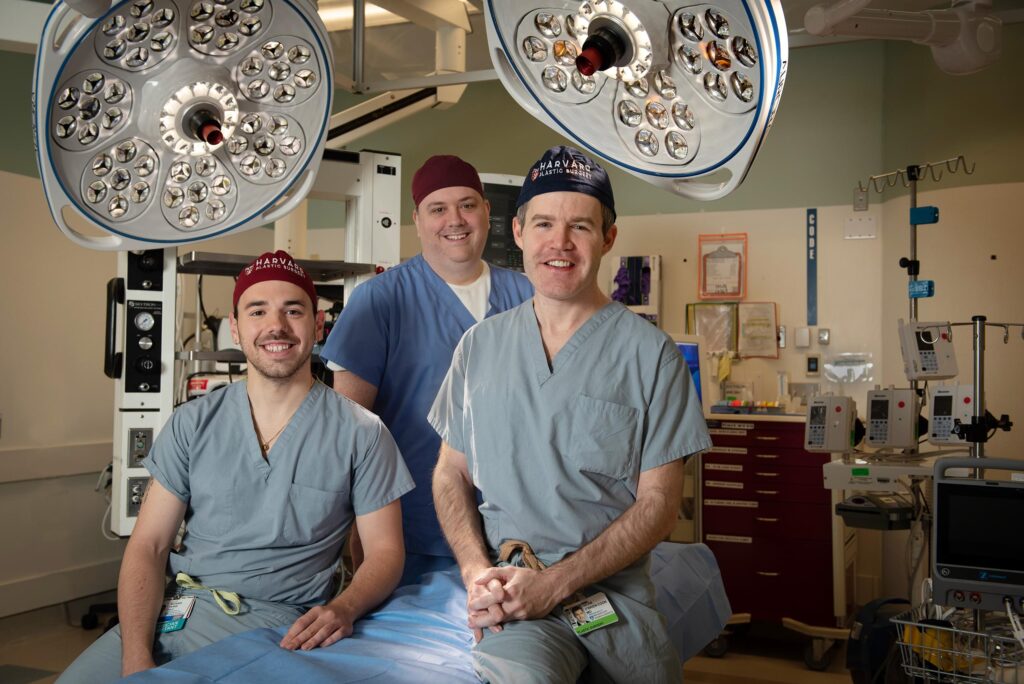
This article appeared in “Care for Every Body,” an issue that received a 2024 Gold Award for Excellence from the Group on Institutional Advancement (GIA) of the Association of American Medical Colleges (AAMC). It also received a 2024 AAMC GIA Robert G. Fenley Writing Award.]
What You Will Learn:
- Despite advances in gender-affirming care, bias against trans and gender diverse people is threatening access to treatment for many who need it.
- The Brigham’s Center for Transgender Health provides state-of-the-art, evidence-based care and is improving understanding of this essential area of medicine.
When Harrison came out as trans in college, he didn’t have much support at first.
“I was anxious, depressed, and often suicidal,” remembers Harrison, now 31. “But I was fortunate to start therapy, and slowly, I felt safe enough to talk about it with my parents during a therapy session. They did not take it well.”
After he graduated, Harrison moved to Idaho from his home state of Pennsylvania. Combining his love of skiing with his training as an EMT, he became a ski patrol paramedic.
Harrison also hoped to begin testosterone therapy—hormone injections or medicated gels to masculinize his body. But while testosterone is commonly used for a range of conditions in cisgender men, Harrison struggled to find a provider in Idaho willing to prescribe the hormone for trans men.
“It took more than a year to be seen for the possibility of getting testosterone,” Harrison says. “Thankfully, I found an OB-GYN physician with a private practice. He’d never seen a trans patient before and didn’t know much about gender-affirming care. Yet he prescribed my first dose of testosterone. Later, he performed my hysterectomy. His open-mindedness and compassion were a lifeline.”
Harrison was relieved to find a supportive doctor. But as a trans man, he often felt anxious receiving medical care in a traditional women’s health practice.
“In the waiting room, I could tell when others were looking at me thinking, ‘Why is that guy getting blood work here?’” he says. “I told my doctor I felt awkward in that situation, and he offered to open his practice early on the days I came in. His consideration of my comfort went a long way.”

Opening new doors to care
Across the country in Boston, hospital leaders at the Brigham envisioned the benefits of a dedicated, comprehensive hub of care for patients like Harrison. In 2022, they opened the Center for Transgender Health, which coordinates a variety of gender-affirming services across plastic surgery, endocrinology, urology, gynecology, dermatology, primary care, voice therapy, physical therapy, mental health, and supportive services.
“We are fortunate to have a large group of passionate professionals in this area of medicine,” says Shalender Bhasin, MD, medical co-director of the center and an expert in gender-affirming hormone therapy. “We are all excited to see the Brigham invest in the center. It’s a wonderful time for growth and further investment in research, clinical care, and medical education and training around transgender health.”
Though the Brigham’s Center for Transgender Health is new, its team of clinicians and scientists have collectively spent decades improving care for trans and gender diverse people. They are sharing that depth of knowledge with colleagues and trainees across the Brigham and its affiliated institutions.
This year, the Brigham’s endocrine fellowship received a record number of applications, bolstered by interest in training on gender-affirming hormone therapy. In the Division of Plastic Surgery, a new clinical fellowship is helping surgeons learn advanced gender surgery techniques. The center will also hold one-month rotations for medical students to gain broader experience in gender-affirming care.
“It’s less stigmatized for students to pursue this area of medicine today,” says Ole-Petter Hamnvik, MB BCh BAO, MMSc, an endocrinologist in the center. “For a long time, this work was concentrated in community centers and specialized LGBTQ clinics. It’s really coming into its own in academic medicine.”
Society and how we think about the role of medicine in gender affirmation has all changed for the better.
Ole-Petter Hamnvik, MB BCh BAO, MMSc
Out of the shadows
Gender diversity may seem to some like a recent phenomenon. But ancient cultures on nearly every continent left evidence of people who embodied gender differently from their sex at birth. Century-old medical literature describes individuals seeking treatment to alleviate gender dysphoria, the pervasive distress of living in a body that doesn’t match one’s internal sense of self.
In the 1940s, Harry Benjamin, MD, a German endocrinologist and sexologist, established the basics of modern transgender medicine. In his private practice in New York City, Benjamin was among the first to use hormone therapy and surgery to meaningfully improve the lives of trans patients. He recorded his findings and helped confirm scientifically that humanity has many gender expressions.
“One of my patients went through her gender affirmation under Dr. Benjamin’s care, so I feel like I am one degree of separation away from the person who started this whole field,” Hamnvik says.
“It’s fascinating to talk with her about her experiences in the 1960s,” he adds. “Because there were so few surgeons who helped trans people, she had to seek breast augmentation underground from a non-professional. And as a trans woman with a manual labor job, she was told to find work more suitable for women before her clinicians would agree to treat her. Society and how we think about the role of medicine in gender affirmation has all changed for the better.”
Bhasin didn’t imagine when he became an endocrinologist that he would be a leading advocate for gender-affirming care. But in too many cases over 35 years, he has seen trans patients whose health deteriorated after experiencing family rejection or intense abuse in their personal lives. Some were veterans who, once their gender identities were discovered, were discharged without honor. Others who had been in prison survived violence and neglect of their medical needs.
“For much of human history, the rigidity of binary sexuality and gender roles has proven to be grossly wrong and a source of immense cruelty to human beings who don’t fit into the binary,” says Bhasin. “The rates of suicide among transgender and gender diverse people are many orders higher than the general population and completely preventable.”
He adds, “We’ve come a long way, but life today is still too hard for trans people. Our recognition of gender diversity has a way to go in both society and science. The NIH [National Institutes of Health] can do more to advance research, care, and civil rights for trans and nonbinary patients. As a medical system, there’s so much more we can and must do.”
Mending past harms
For the many trans and gender diverse individuals who don’t have timely access to hormone therapy in adolescence, Hamnvik explains the path of medical gender affirmation can be challenging. The start of menstruation, breast development, facial and body hair growth, and other bodily changes of puberty can be distressing when they don’t match an individual’s gender identity. Later in life, it can be impossible to undo some physical changes with hormone therapy alone.
“This is when surgery becomes necessary,” he says. “Some physical changes can’t be reversed, which unfortunately means patients may not have all of their goals met. There’s also the added complexity that the older we get, the more medical problems we must treat. It’s sometimes tricky to balance health conditions with hormone therapy. We must collaborate with other specialists to maintain patients’ overall health throughout the course of their lives.”
Sari Reisner, ScD, the center’s director of research, says the last decade has seen a vast increase in scientific literature on trans health. He and his colleagues are helping translate those findings into better clinical guidelines, particularly through the World Professional Association for Transgender Health (WPATH), a global organization that publishes guidelines for gender-affirming care.
“Developing WPATH’s guidelines is a massive undertaking that required consensus-reaching around definitions, best practices, and contexts of care and where it is delivered,” Reisner says. “It was an honor to be part of an effort that is improving how we care for trans and gender diverse people in every culture and community.”
Though research has helped illuminate treatment paths for trans patients, Reisner acknowledges major evidence gaps persist for the larger and growing nonbinary population.
“What are the care needs of nonbinary people?” he asks. “Right now, that’s a conversation largely between individuals and their providers. But what if we have better population data to guide those conversations? That’s an exciting, open
area of work.”
Beyond the binary
Grace McElroy-Howard, who is 26 years old and nonbinary, felt uncertain about their gender identity before their teenage years. Their stronger sense of being gay was easier to navigate than accepting they were neither a girl nor a boy.
“I always knew identifying as a gay woman was not the whole truth for me, but any other identity felt inaccessible, at least until I was older and had a chance to explore it more deeply in therapy,” says McElroy-Howard. “I started to tap into the pain I felt going through puberty, what I recognize now as gender dysphoria.”
McElroy-Howard started to feel grounded in their nonbinary identity through therapy and talking with their family and friends. They also had conversations with their primary care physician, Colleen Monaghan, MD. Monaghan is the medical director of Family Care Associates, one of the Brigham’s primary care practices.
“As a combined medicine-pediatrics clinic, we take care of patients from birth and get to meet them in their childhood and young adult years to much older age,” says Monaghan. “We are having conversations about gender identity across the lifespan, asking patients how they identify, what pronouns they use, their sexual orientation and sexual history, and not assuming they are heteronormative or straight.
“It’s also important to let this conversation evolve,” she adds. “If you ask a patient about their gender identity or sexual orientation just once and never again, you aren’t modeling acceptance of how these identities and expressions may evolve.”

Monaghan says this simple practice of asking and not assuming gender identity is new to many healthcare providers. And though asking takes mere seconds during an appointment, providers who affirm and normalize gender diversity can have an enduring impact. They build trust with patients who are trans and gender diverse and increase awareness of gender diversity for all patients who come to the clinic.
Crucially for McElroy-Howard, having space to talk openly with Monaghan about their gender identity helped clarify their long-term health goals.
“It became clearer that top surgery was a priority for me,” McElroy-Howard says. “And even with so much support, it wasn’t easy. We had lots of back and forth with my health insurance, which required a letter from my therapist stating the procedure was medically necessary before they would approve it.
Looking back from where I am now, I wish I could tell my 16-year-old self to hang in there. It’s going to be okay.
Grace McElroy-Howard
“It took so much time and work to feel strong and confident in who I am,” they say. “And yet I still felt guilt and questioned if I was worthy of this care, especially when so many others can’t get it.”
Climbing the next hill
Harrison knew his life was changing for the better the first time he took off his shirt at the beach after top surgery.
“To feel the sun on my chest and back, to literally feel the warmth—was the most transformative, liberating moment,” he says. “I can’t even describe what that did for my confidence.”
Galvanized by the positive changes he saw in himself, Harrison was ready to continue his medical transition. Through an online community for trans patients undergoing medical and surgical transition, Harrison learned about Devin O’Brien-Coon, MD, MS, a renowned plastic surgeon who specializes in gender-affirming phalloplasty, a complex series of procedures to give trans men a fully functioning penis.
Constructing an organ as complicated and multifunctional as a penis, on a body that didn’t have one before, is a technical achievement few surgeons have perfected. One of them is O’Brien-Coon, who came to the Brigham from Johns Hopkins in 2021 to direct the Center for Transgender Health and serve as the center’s surgical lead.
“As surgeons, we have our own ideas of what a successful surgical outcome looks like,” says O’Brien-Coon. “With any kind of surgery, and particularly gender-affirming surgery, how a patient feels about the result has major implications for their overall health and well-being.”
Harrison spent a year on a waitlist to meet with O’Brien-Coon. While out on a search-and-rescue mission in the Idaho mountains, he got the phone call that O’Brien-Coon could take his case. Harrison first saw O’Brien-Coon at Johns Hopkins and continued under his care at the Brigham.
“I trusted him with my life and my future,” he says. “I had to fly cross-country for every appointment, and I would do it all over again.”

Advocates in every corner
Given the complexity and significance of Harrison’s procedure, the operating room was packed with specialists across plastic surgery, urology, and other disciplines, and many trainees eager to learn. Physician assistant Michael Parisi, PA-C, was with Harrison through his whole surgical journey.
“Harrison was among the first patients to interact with all members of our multidisciplinary team,” Parisi says. “In the OR, we were able to do some informal teaching with the nursing and anesthesia staff assigned to his case. On the floor, he was happy to educate the nurses about his transition experiences.
“I am new to the field of gender-affirming surgery, so it’s been an amazing learning opportunity for me,” Parisi adds. “The fact that I got to do it with Harrison as one of my first patients made it so much more comfortable.”
A standout memory for Harrison came after surgery: he had a 3D CT scan of his urethra, the first patient at the Brigham to undergo this imaging, to make sure the procedure successfully allowed him to urinate from his newly constructed penis.
“You’d think it would be this horribly awkward situation having to pee in a room full of people, in 3D,” Harrison laughs. “However, I thought it was wonderful to help a whole group of doctors, physician assistants, and technicians learn about the plastics and microbiology used in my surgery, and how they will translate in the real world in my daily life.”
A year later, Harrison still thinks about every nurse, aide, and environmental service staff member who helped him through his week-long inpatient stay. “Each one wanted to know how they can take better care of trans people,” he remembers. “I was never misgendered. I was never thought of as a lesser patient. If anything, I was glorified.”
Of all the people who made his experience a success, Harrison says, the most meaningful person was his mom. She was by his side as he recovered in the hospital and in a nearby hotel room for six weeks so he could attend weekly postoperative appointments.
My mom recognized I was the same person she raised. I wasn’t a different person; just a happier one.
Harrison
“Ultimately, my mom recognized I was the same person she raised,” he says. “I wasn’t a different person; just a happier one. I still thought the same things were funny, my favorite foods were the same, and I loved the same sports that I did growing up. It would have been impossible to get through this without my mom. Not just emotionally—physically, I would not have made it.”
Ready to be seen
Harrison had his final follow-up appointment with O’Brien-Coon in 2022. With his 5-year-long medical odyssey at an end, he and his wife are enjoying life in the mountains of North Carolina, where they moved to be closer to family.
Back in Boston, McElroy-Howard recently underwent their long-awaited top surgery at the Brigham.
“Some people might find it dramatic to say this care is life or death, but it is,” says McElroy-Howard. “Having bodily hatred is severe and the treatment for it does not feel elective. I feel blessed to be local to Boston and to able to pursue this care without too many barriers. But I am sad that so many others in this country are struggling to access support in their own communities. It is costing lives.”
Too many people experiencing gender dysphoria put their heads downs and bear through it, they add. “It’s respectable to want to be strong. But it’s so much more important to get the care when you need it and as soon as you can. Looking back from where I am now, I wish I could tell my 16-year-old self to hang in there. It’s going to be okay.”
Many providers and patients don’t want gender-affirming surgery or hormone therapy to be seen as medical marvels. They don’t want pronouns to be a lightning rod for social and political discussion. More than anything, they want gender diversity and affirmation to be normalized.
“We need more gender-affirming support across the hospital, and not just in the Center for Transgender Health,” Bhasin says. “We need to continue mainstreaming the terminology across the organization so all providers can serve our trans and nonbinary patients with competency and sensitivity.”
For the thousands of trans and gender diverse people living in New England, and many more beyond, O’Brien-Coon says he and his team are committed to making the center a top program for gender-affirming care in the country.
“I have patients from states that are hostile to their healthcare,” he says. “We have a limited ability to do much about the circumstances they may be facing at home. But one thing we can do at the Brigham is to be a place of welcome and an institution that is unapologetically inclusive, come what may.”

